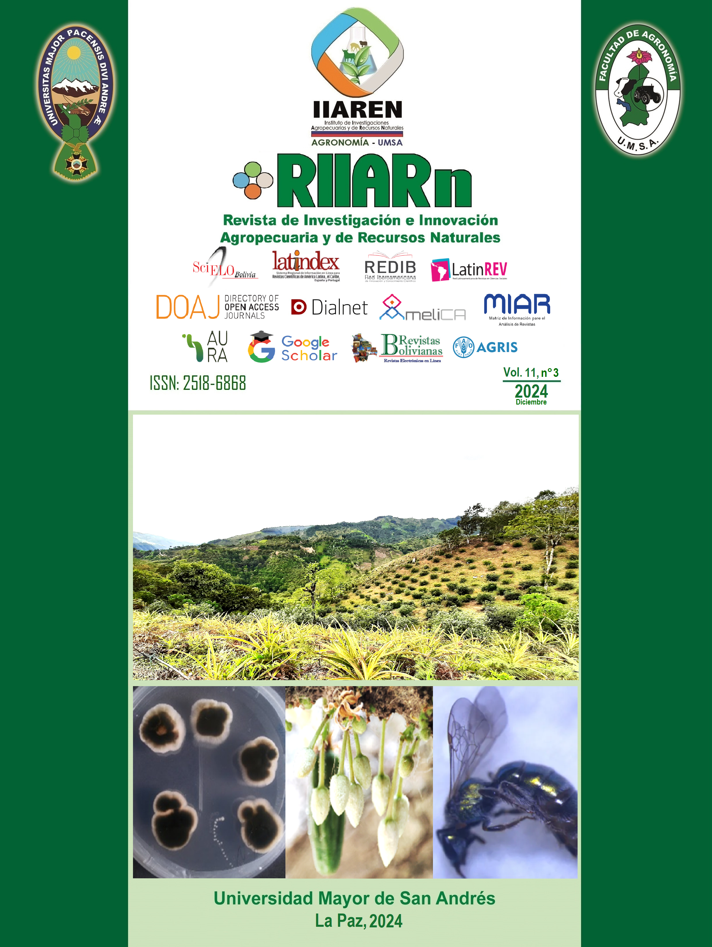Characterization of organic and conventional coffee (Coffea arabica L.) farms in the Intag area, Ecuador
DOI:
https://doi.org/10.53287/iisy1664yp50tKeywords:
associativity, agroforestry, production systems, Coffea arabica L. typica, bourbonAbstract
The cultivation of coffee (Coffea arabica L.) in Ecuador is economically important for exports, and the Andean regions provide ideal conditions for high-quality altitude coffee. The objective of this study was to characterize coffee-producing farms in the Intag region, Ecuador. The study involved a population of 273 coffee farms, from which a sample of 116 producers was obtained. The survey included questions related to socioeconomic and technical aspects. A correspondence analysis using mutual information was conducted in RStudio to verify relationships between categorical variables. Additionally, Pearson correlation analysis was performed using a generalized linear model with elastic nets (Machine Learning models) and cross-validation to separate numerical data to determine a logistic regression model. The results show that the coffee farms are mainly organic, organized, and associated, with small-scale farms, lack of technological innovation, and low yields. These farms exhibit a high diversity of crops through agroforestry systems, primarily Musa spp., Manihot esculenta C., and Alnus nepalensis D. alongside coffee. Additionally, livestock production contributes to increased family income and bio-inputs for the farms. The marketing system operates through two associations, one organic and the other conventional, focused on producing specialty coffees for local and international markets. The cluster analysis identified two groups: one with 84 organic farms (69 %) and another with 32 conventional farms (31 %). The first group cultivates Typica (45 %) and Bourbon (55 %), has better agroecosystem management, and uses beneficial microorganisms to combat pests and diseases, resulting in higher market prices due to organic certification.
Downloads
Published
How to Cite
Issue
Section
License
Copyright (c) 2024 Telmo Fernando Basantes-Vizcaíno, Julio Cesar Alegre Orihuela

This work is licensed under a Creative Commons Attribution-NonCommercial-ShareAlike 4.0 International License.

Revista de Investigación e Innovación Agropecuaria y de Recursos Naturales por Instituto de Investigaciones Agropecuarias y de Recursos Naturales, Facultad de Agronomía, Universidad Mayor de San Andrés se distribuye bajo una Licencia Creative Commons Atribución-NoComercial-CompartirIgual 4.0 Internacional.
Basada en una obra en http://riiarn.umsa.bo.
LOS AUTORES RETIENEN SUS DERECHOS:
a. Los autores retienen sus derechos de marca y patente, y también sobre cualquier proceso o procedimiento descrito en el artículo.
b. Los autores retienen el derecho de compartir, copiar, distribuir, ejecutar y comunicar públicamente el artículo publicado en la Revista de Investigación e Innovación Agropecuaria y de Recursos Naturales (por ejemplo, colocarlo en un repositorio institucional o publicarlo en un libro), con un reconocimiento de su publicación inicial en la revista Revista de Investigación e Innovación Agropecuaria y de Recursos Naturales.
c. Los autores retienen el derecho a hacer una posterior publicación de su trabajo, de utilizar el artículo o cualquier parte de aquel (por ejemplo: una compilación de sus trabajos, notas para conferencias, tesis, o para un libro), siempre que indiquen la fuente de publicación (autores del trabajo, revista, volumen, número y fecha).


